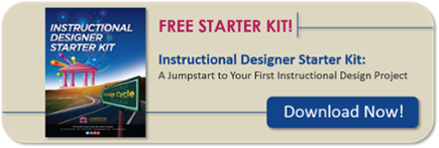
Photo by: Annie Spratt via Unsplash
Instructional Designers are constantly faced with the challenge of putting together solid performance-based training that sets learners up for success on the job. Their real-world circumstances are often less than ideal as they are consistently asked to work their magic with tight and unrealistic constraints. As training professionals, we know there is no magic wand, but we do have choices. One of those choices is blended learning. It offers the instructional designer a variety of strategies to choose from to help solve the complexities of the work environment’s training needs. There is no perfect blend of strategies, but there is a 3-step process we explore in our Blended Learning workshop that helps simplify the decision-making process.
Step 1: Identify Constraints
Before you choose a core strategy, like traditional instructor-led training or e-learning, you must first identify the instructional design constraints you are facing (e.g. time, budget, organizational mandates/policies, technical, design, etc.). This is a critical first step.
Step 2: Select Strategy
Once you have identified your constraints, it is time to consider the best core strategy (or strategies) that is most feasible for the type of content you are designing for. Will it be a traditional strategy, an e-learning strategy, or a combination? Not only do you need to assess the type of content, you will also need to consider other key factors such as the location of the learners, available resources, and deadlines, along with their implications.
Step 3: Consider Performance Support Activities
Unfortunately, we don’t live in an ideal world. Due to tight constraints, the instructional designer may need to incorporate Performance Support Activities (PSA’s) to support the core training strategy solution. While there’s a wide variety of PSA’s, some of the most common are coaching sessions, assigned reading, and group discussions and assessments.
Remember, there is no perfect blend. If you would like to explore best practices and dig a little deeper into the available strategies and options, I encourage you to register for our Blended Learning workshop. You may discover the ideal blend for you!
Note: This post is part of a workshop intersession activity. As such, it is monitored in a slightly different manner than the other blog posts on our website. If you are not a participant in the applicable workshop, but have a question you would like answered, please feel free to contact us.


64 Responses to “A 3-Step Decision-Making Process for Blended Learning”
I enjoyed learning about the three steps in order to create blended courses. It’s going to be interesting to learn more today (on day 2).
I love this blended approach to training. It reinforces key learning and also helps support learning in every training program.
These steps are key in designing a successful blended learning.
It is amazing to determine the core training, the performance support activities, and prioritize the tasks based on constraints.
Very interesting training!
The task prioritization workshop is a great tool to make sure that objectivity is guiding your prioritization.
I really like the use of three steps. It can really help narrow the focus when planning new or updated training.
It’s great to have a methodological basis for decision making in regards to training solutions. I see tasks/topics prioritization formula as a valuable exercise for all stakeholders to discuss and later make informative decisions.
I’ve been in several situations where I am building a full curriculum – not just a course – under severe constraints. The process and strategies used for building blended learning are perfect for making the best possible decisions on how to develop effective training in those situations.
I feel that the blended learning approach is a good approach for training. The way to identify and prioritize the constraints is helpful. Also, the PSA are necessary for a successful training environment.
Blended Learning has many benefits and unlocks otherwise rigid delivery systems because that’s the way we always did it! This has a wide range of options and if you use the tools provided in this course, you will be working the most efficiently and effectively from the design side, while adding more engagement for the Learners.
Great training.
I think blended learning is a great solution to many of the constraints faced by course designers. It is a flexible and versatile approach to learning/teaching that can be applied in many different ways/settings.